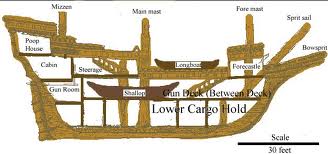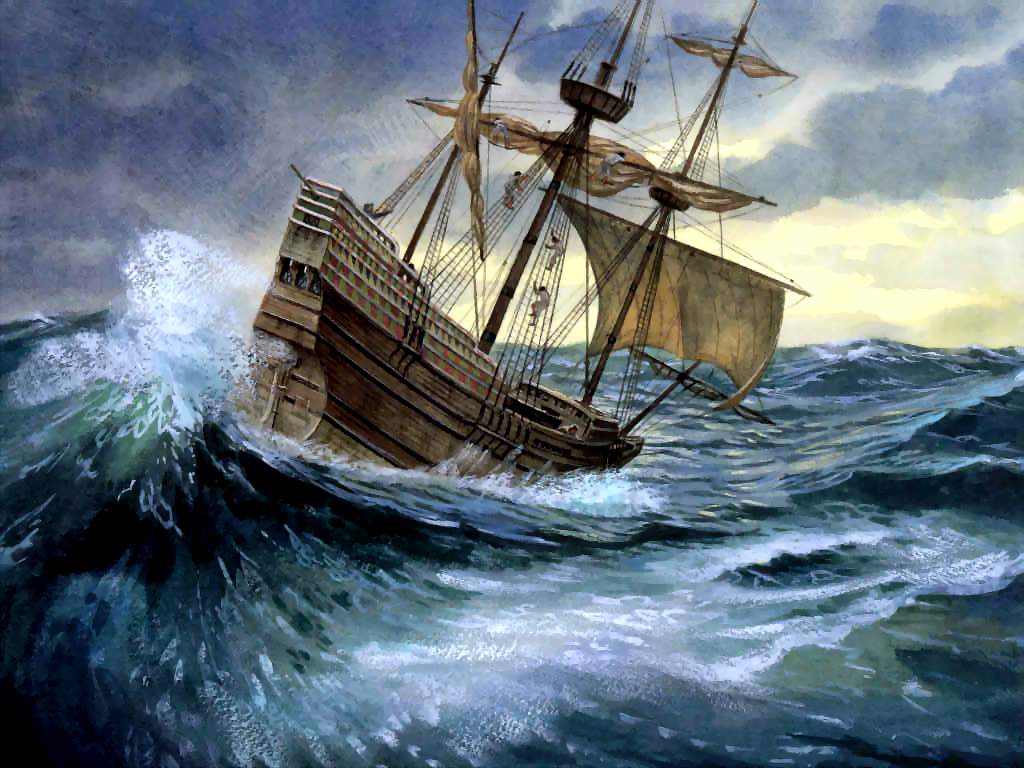Learning about Thanksgiving Part II:

The Mayflower
Mayflower ship history:
The Mayflower left Plymouth, England on September 6, 1620, with 102 passengers (three of which were pregnant women), and a crew of about 30.
 One of the sailors on the voyage was remembered as having been very vulgar and rude. He used to laugh at the passengers sea-sickness, and told everyone he hoped to throw half of them overboard after they had died, and then take all their possessions for himself. He cursed and swore terribly. In the end, though, he ended up being the first to get sick, and soon died of a very painful disease, and was in fact the first person thrown overboard. The Pilgrims saw the hand of God in his death, as Bradford wrote “Thus his curses light on his own head, and it was an astonishment to all his fellows for they noted it to be the just hand of God upon him.”
One of the sailors on the voyage was remembered as having been very vulgar and rude. He used to laugh at the passengers sea-sickness, and told everyone he hoped to throw half of them overboard after they had died, and then take all their possessions for himself. He cursed and swore terribly. In the end, though, he ended up being the first to get sick, and soon died of a very painful disease, and was in fact the first person thrown overboard. The Pilgrims saw the hand of God in his death, as Bradford wrote “Thus his curses light on his own head, and it was an astonishment to all his fellows for they noted it to be the just hand of God upon him.”
After 55 days people were tired, cold and sick. A baby was born in the dark hold of the ship and the infant was somehow kept alive. Tempers were short and food was scarce. Fresh drinking water was almost gone and had to be rationed. There were 11 more days at sea but they did not know that.
On the morning of November 9, after more than two months at sea they spotted land, which they later found to be Cape Cod. After 2750 miles, traveling at an average speed of just under 2 mph, the voyage was nearly over. (From The Mayflower Quarterly, Vol. 69, No, 4, December 2003)
Mayflower ship facts for kids:
The Mayflower was a cargo ship. Cargo ships do not have places to sleep. The space within a cargo ship is like a warehouse and is used to stow the heavy weight of cargo such as lumber. The weight (ballast) down low gave the ship “stability” and helped resist leaning over due to the force of the wind. On this trip the passengers and their belongings were the ballast.

Inside the Mayflower
All ships, including the Mayflower, have a right-hand side and a left-hand side. As one faces the bow of the ship (the pointy end which moves forward), the side of the ship which is to your right is called the “starboard” side. The side of the ship to your left is called the “port” side. This designation came about because the ship’s rudder was once called a “steer board.” The “steer board” was always on the right side of the ship as one faced the bow. When the ship docked in port, they could not dock with the “steer board” next to the pier so they docked with the other side next to the pier. The other side (which lay against the pier) became know as the “port” side. Somehow “steer board” became “Starboard.”
As the Mayflower made her way west towards “Virginia,” the wind was usually hitting the starboard side (from a northerly direction). As this north wind made contact with her sails, the Mayflower would lean over (heel) to the left (port). This meant the deck was at an angle to the surface of the earth and the Pilgrim passengers, even if they were giving birth, had to adjust to this angle of the ship’s leaning.

It wasn’t always smooth sailing!
Stand in the living area of your home and look at the light switch. Then imagine: if somehow, the light-switch side of the floor, upon which you stand, is suddenly elevated to the position of the light switch (heeling) while the other side of the floor dips lower than it is. Then imagine yourself trying to stand up straight when that (sloping) happens. Consider that circumstance, which lasted for days on the Mayflower, and then consider the waves causing the bow to fall down in troughs and the stern to rise at the same time. Imagine trying to eat! Imagine trying to give birth! Imagine trying to pray!
Learning Activities about the Mayflower for kids :
- You can learn what it was like to sail on the Mayflower with this game.
- Here an audio recording of a reporter giving the details of the sailing of the Mayflower from Plymouth Harbor in England.
Mayflower Crafts for Kids:

Mayflower Crafts
Books about sailing in the 1600’s for kids:
- If You Sailed on the Mayflower in 1620 by Ann McGoveren
- On the Mayflower by Kate Waters. In lively question-and-answer style, this fact-filled book answers all sorts of questions about the Pilgrims’ journey on the Mayflower and their first year in America.
- Tattered Sails by Verla Kay. An upbeat, beautifully illustrated story about one family’s 1653 journey to the New World.
- Mayflower 1620: A New Look at a Pilgrim Voyage by Catherine O’Neil Grace. Sometimes it takes actual photographs to help kids understand that something actually happened. This book is great for that, as it is full of photographs taken on the Mayflower II and depicts what life would have been like aboard ship.
- You wouldn’t want to sail on the Mayflower!: a trip that took entirely too long by Peter Cook. High interest topic for children of all ages. – Draws in even the most reluctant reader with a lighthearted tone and hilarious illustrations.

Possibly Related Posts:
- My Christmas Gift to You
- Why take Your Kids Camping?
- Make it Special – Chores and Family Work
- Martin Luther King Day and Black History Month
- Tools to Make 2013 Better – Say NO to New Years Resolutions!!



{ 1 comment… read it below or add one }
Love this! Thanks for sharing! 🙂